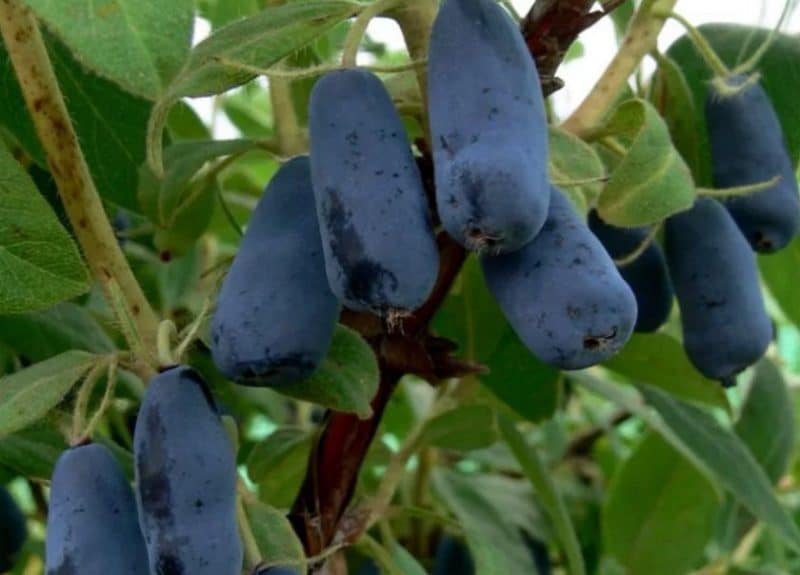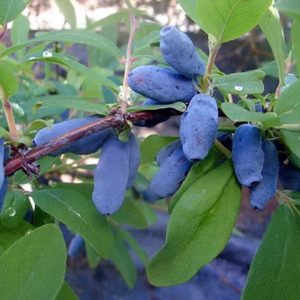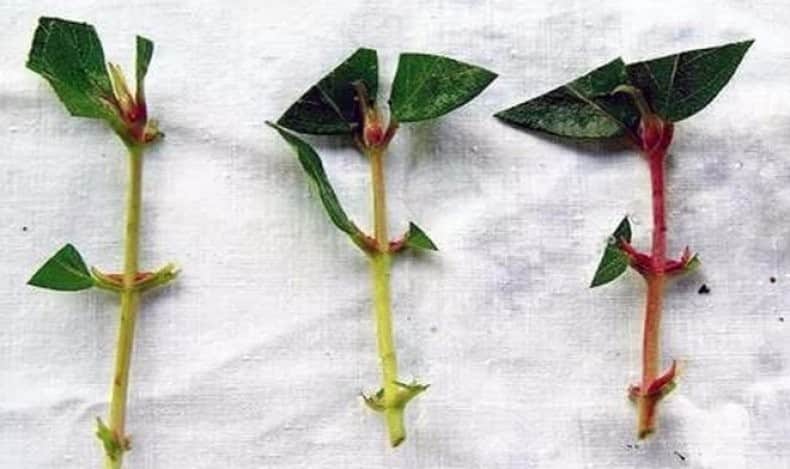Mid-season unpretentious variety of honeysuckle Volkhov
Volkhov honeysuckle is valued by gardeners for its unpretentiousness, winter hardiness and tasty fruits. The variety is adapted for cultivation in the north-west of Russia, because its homeland is the Leningrad region. Let's consider the features, advantages and agricultural technology of Volkhov's blue honeysuckle.
Description of the honeysuckle variety Volkhov

A bush with a dense oval-shaped crown, with numerous shoots and flat dark green leaves. The erect, fleecy branches are thin, but unbreakable and can withstand the weight of the crop and bad weather. Plant height – up to 200 cm.
The bluish fruits are elongated in length and reach a size of more than 2 cm with an average weight of 0.7 g. The top of the berries is slightly pointed, the skin is thin. The pulp is dense, with a sweet and sour taste, slightly reminiscent of strawberry. With a tasting score of 4.7 points, Volkhov’s honeysuckle is deservedly called a dessert crop.
Reference. One of the valuable properties of the variety is low fruit shedding.
Origin and development
The honeysuckle variety in question was obtained at the Vavilov Plant Growing Station at the end of the 20th century. Breeders took the seeds of the Pavlovskaya variety as a basis.
In 1999, the variety was included in the Register of Crops of the Russian Federation, giving it the name Volkhov after the name of the river flowing in the Leningrad region.
Characteristics, appearance, taste
The Volkhov variety is mid-early. From one bush you can collect 2-3.5 kg of bluish-gray fruits with an exquisite strawberry aroma.
The acid is almost not felt, and the chemical composition of each berry is rich in vitamins and microelements.
Average indicators of Volkhov honeysuckle fruits:
- sugar – 8.4%, including fructose – 2%;
- dry matter – 19%;
- acids – 1.9%;
- vitamin C – 56.3 mg/100 g.
The berries are also rich in B vitamins, provitamin A and vitamin P.
Features of application
The variety is universal. It is successfully used for preparing preparations (compotes, jam), tinctures and for freezing. The fruits taste good in any form - fresh or canned.
The bushes are also cultivated as hedges, which achieves double benefits - a tasty harvest and a thick, dark green fence. The plant is unpretentious, so its location is possible in any part of the garden, regardless of shade and climate in the region.
Reference. Volkhov honeysuckle berries have anti-inflammatory and choleretic properties. Regular consumption also reduces the risk of developing cardiovascular diseases.
Productivity and fruiting
The variety has 2 features - early ripening of a large number of berries (up to 3.5 kg per bush, subject to regular watering) and the ability to retain them.
Due to the fact that the fruits remain in place, the yield of the variety can be called high. The average is 2 kg per adult bush.
Ripening period
The variety begins to bear fruit one of the first. By the end of June, the bluish aromatic berries are ready for picking.
In regions with a cool climate (Moscow, St. Petersburg), technical maturity occurs 1.5-2 weeks later, which does not cancel the position of Volkhov’s honeysuckle in the ranking of quick-ripening crops.
Resistance to diseases and pests
Volkhov's honeysuckle is resistant to diseases and pests.With proper planting and timely care, the bush can live 20-25 years without being attacked by insects or affected by infections.
Resistance to cold and drought
Adult bushes survive at temperatures down to -40°C. Leaves and flowers are stored at -8°C.
Young shoots must be covered when the thermometer drops to +3°C. For mature plants, a layer of snow becomes a natural shelter.
In arid regions, bushes require regular watering, since the lack of moisture has a detrimental effect on the quantity and quality of the crop.
Suitable regions and climate requirements
Volkhov's honeysuckle tolerates the harsh climatic conditions of the Russian winter well, but is poorly adapted to heat and drought.
Despite the possibility of cultivating the variety throughout Russia, the best fruiting results are achieved in the Central and North-Western regions of the country, where there is enough rainfall and there is no intense heat.
Volkhov's honeysuckle: advantages and disadvantages
Advantages:
- excellent winter hardiness;

- consistently high productivity;
- ease of care;
- low crumbling;
- pleasant taste and aroma properties;
- rich microelement and vitamin composition;
- versatility.
Flaws:
- self-sterility, which requires the placement of pollinating plants nearby;
- relatively small berries;
- impossibility of transporting fruits over long distances due to poor keeping quality;
- Fruiting occurs 3-4 years after planting.
Difference from other varieties and hybrids
The key difference between the Volkhov honeysuckle variety is the preservation of the berries on the bushes. The absence of self-falling of fruits allows the crop to be grown on an industrial scale, where harvesting is carried out by combines.
It is possible to cultivate honeysuckle in cold areas where other varieties and hybrids die under the influence of low temperatures or lose their harvest due to gusts of wind.
Agricultural technology
Volkhov's honeysuckle is an unpretentious plant. However, placing bushes in a draft or shaded area that receives little sunlight can lead to slow growth and low yields.
For planting, seedlings 3 or 6 years old are taken, and the latter need to be cut to 50 cm.
Choosing a place in the garden and preparing holes
Experienced gardeners plant honeysuckle along a fence or other enclosing structure, which can serve as a natural protection from gusts of wind. At the same time, the bushes themselves must receive enough light.
It is worth choosing the south side of the garden and a remote place from other fruit trees and shrubs that will shade the honeysuckle or take away its nutrition.
Preparing holes for 3-year-old plants is simple:
- Dig a planting hole 40 cm deep and 50 cm wide.
- Water the bottom generously.
- Add humus, 1 kg of ash, 15 g of superphosphate and 70 g of potassium salt.
When planting 6-year-old plants, the dose of fertilizer is doubled.
Preparing for landing
For replanting, it is better to choose plants grown in a container or with an open root system. It is easy to transfer the earthen lump from the container without damaging the delicate roots. Such seedlings take root better, get sick less often and bear fruit well.
Important! The seedling must be grown in a container and not moved from its permanent location at the time of sale. Carefully inspect the soil and the appearance of the plant: a recently moved bush usually looks worse than those that have not been touched since planting.
Soil requirements
Volkhov's honeysuckle loves light, moist, breathable soil. Preference is given to slightly acidic, non-sandy soils that warm up well.
Sawdust or peat must be added to heavy soil to increase moisture and breathability. For swampy areas or areas with high groundwater levels, it is necessary to provide drainage in the form of expanded clay, broken bricks or coarse sand.
Dates, scheme and rules of planting
The best time for planting Volkhov honeysuckle in open ground is considered to be autumn, namely the end of September - mid-October. At this time, the plant takes root better, actively grows its root system and stratifies, i.e., hardens under natural conditions.
When transplanting a seedling, you must carefully straighten the roots, carefully lower them into the hole, sprinkle them with soil and water them thoroughly. Since honeysuckle bushes are voluminous and tall, the distance between them should be 2-2.5 m. If planted closer, the crop will develop poorly; further, cross-pollination will not be possible.
Features of cultivation
Watering is a key point in growing honeysuckle. Without enough water, the bush will grow and bear fruit poorly, and the berries will be bitter and loose. It's also not worth pouring. The soil around the roots should be slightly moist.
As long as the shrub does not bear fruit, no special action is required. Periodic feeding, prevention of diseases and pests, as well as pruning dry shoots fully satisfy the needs of an unpretentious plant.
Immediately after planting, the root space must be mulched to retain moisture longer. Mulch should be updated as needed.An important point is loosening the soil, which improves air exchange in the soil. However, loosening must be done carefully so as not to damage the root system.
Volkhov's honeysuckle needs periodic feeding. In the first 3 years, preference is given to nitrogen fertilizers, which are applied at intervals of 2-3 weeks. Then complex fertilizing is used 2 times - during leaf opening and flowering.
Pollinators
The Volkhov honeysuckle variety is self-sterile, that is, it does not pollinate on its own.
In order for the plant to bear fruit, it is necessary to plant other varieties nearby, for example, Pavlovskaya, Bakchar giant, Amphora, Yugan, Azure. In one corner of the garden, it is allowed to plant up to 4 varieties of honeysuckle at a distance of 2-2.5 m from each other.
Reference. Bees do not participate in the pollination of Volkhov honeysuckle, only bumblebees.
Disease and pest control
Adult honeysuckle bushes are little susceptible to diseases and insect pests. However, young shoots are not so resistant to aphids and honeysuckle borer.
In the first years of cultivation, it is necessary to prevent diseases and reproduction of pests with special insecticides and folk remedies.
If the appearance of borer is noticed, you need to trim the bushes as low as possible, then burn the trimmings and sprinkle the remains of the plant with ash.
Important! Measures to protect Volkhov honeysuckle from pests and diseases are taken only after harvesting.
Preparing for winter
Despite its cold resistance, honeysuckle needs to be prepared for the coming winter, especially young shrubs.
The plant is covered with spruce branches or fallen leaves when the temperature drops below +3°C. It is enough to sprinkle bushes older than 5 years with snow.
Reproduction

Planting material is cut from young shoots of Volkhov honeysuckle in late autumn or early spring before the buds open. The crop is propagated using cuttings or simply dividing an overgrown bush.
Difficulties in growing
Cultivating Volkhov's honeysuckle does not bring any particular difficulties. Standard procedures for watering, fertilizing, disease protection and pruning, familiar to experienced gardeners, do not differ from the cultivation of other varieties of honeysuckle.
The cold resistance and unpretentiousness of the plant allow you to obtain a useful harvest in almost any climatic conditions, and with proper preparation and care - on any soil.
Harvesting

The harvest of bluish berries is ready for harvest at the end of June - mid-July (depending on the climate in the region). Experts recommend waiting a week from the moment the berries turn blue. This period allows the accumulation of density and sweetness sufficient for fresh consumption or canning.
The shelf life of the berries is relatively low, so they cannot be stored for longer than 2 weeks and transported over long distances.
Reference. The Volkhov honeysuckle variety is suitable for growing over large areas, as it allows harvesting using machinery.
Reviews from experienced gardeners
Summer residents note the variety’s resistance to frost and the high taste of the fruit.
Anna, Moscow: “The plant tolerates the harsh winters of the Moscow region well, but if there is little snow, I additionally sprinkle the root space. The berries are very tasty, dense, slightly reminiscent of strawberries. It makes a delicious compote.”
Maxim, Kostroma: “I planted honeysuckle Volkhov and its pollinator Yuganu on the site. After 4 years I received my first harvest.There are a lot of berries - we made jam, compotes, and had some left over to freeze. There weren’t any particular difficulties, only sometimes I water it with an ash solution, since our soil is acidic.”
Conclusion
Volkhov's edible honeysuckle received the most important qualities of a berry crop during the selection process: consistently high fruiting, frost resistance, unpretentiousness to environmental conditions and care.
Tall bushes wonderfully delimit the space of a garden plot and bear many useful berries.